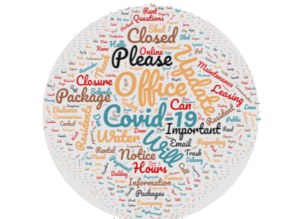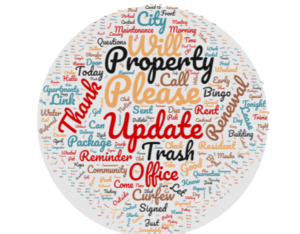Finding patterns in multifamily resident communication during COVID-19
In the multifamily industry, the third Thursday of any given month should be the definition of normal. Rents for the month have been collected and late payments have been handled, one way or another. Payments for the next month are still a week away. The weekend is coming, and with it, increased resident and prospect traffic. If any day should be able to represent the average day, it is the third Thursday of a given month.
With that in mind, we looked at key word analysis on broadcast messages sent from multifamily properties to residents and compared the third Thursdays of February, March and April 2020. These can also be thought of as before COVID-19, during the COVID-19 upheaval and after a period of adjustment to new policies and behaviors.
Before: February 20, 2020
Do you remember life before COVID-19? A quick headline search for this date reveals little out of the norm. The Democratic debates welcomed Michael Bloomberg to the stage, Sprint and T-Mobile revised their merger terms, the NBA returned from the all-star break and garlic prices were rising due to supply chain impacts from the coronavirus outbreak in China. All normal news, with only a tangential reference to the coronavirus. Given the normal state of the world at this moment, this date is a good example of typical communications between properties and residents. A word cloud depiction of text and email subject line content from that day is shown here.

As you can see, the tone, tenor and topics of February are mundane at best, as the word cloud is littered with words that evoke day-to-day operations – clearly depicting a typical day in the community.
During: March 19, 2020
The week of March 19, 2020 was a watershed moment as it relates to the COVID-19 pandemic in the United States. The impact of the virus was becoming quite clear: sports leagues had stopped, Saint Patrick’s Day parades had been cancelled, Spring break was scuttled and college students as well as K-12 children were sent home. Businesses began to determine essential from non-essential, and where possible, employ telecommuting. This was the week that the White House issued social distancing guidelines and property staff across the country quickly reacted, setting new policies and communicating with their residents. See the word cloud below:

As is visible from the above graphic, the most dominant key words were driven by COVID-19 and the impacts on property operations. Notifications of office closures, new hours and messages about changing package handling practices dominated the message volume and represent a clear view of an industry in transition in the midst of a pandemic.
After: April 16, 2020
April 16, 2020 yields insight into our current “normal” and the focus of property management on operations and resident care. This is not our new normal yet, as shelter-in-place orders remain and the economy is not fully “open.” We have, however, adjusted to the change from February to April, having settled into a new routine of property operations as evidenced in the following word cloud.

The word cloud from April 16 shows a substantial increase in messages regarding trash, a clear result of shelter-in-place residents creating more trash per day as compared to normal conditions. Messages about renewals and leasing also had drastic improvements, while package related messages saw a decrease. There were hardly any messages directly referencing COVID-19; in fact, it was overshadowed by messages about Bingo and other socially-distant social activities.
I must say that it is nice to see the word “please” appear in equal prominence across all three images. Thank you for that.
From the looks of it, things have settled for now, and apartment communities have regained a focus on traditional operations under new these new circumstances, the current normal. Change, unfortunately, is not over, as the economic impact on residents and the scope, scale and timing of an economic re-opening remains unknown.
Looking ahead
Regardless of what the future brings, communication between multifamily properties and residents is getting a lot more attention than usual. We’ve learned that the need to share information and provide guidance to communities can be a public health matter. In analyzing messages sent during this tumultuous time period, it’s clear that the industry responded quickly and continues to adjust as we search for the new normal.
An MRI Client Success Story: Southwood Realty
How Southwood Realty revolutionized their business with the MRI Living toolbox Founded in 1977, Southwood Realty is a family-owned property management company based out of Gastonia, North Carolina. With locations in North Carolina, South Carolina, Te…

